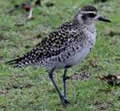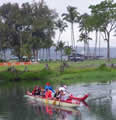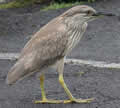2015/03 Hawaii trip - Hilo's gardens |
|||||
 Sunday March 8th
Sunday March 8th
North America was now on Daylight Savings Time, but Hawaii, like most tropical places, doesn’t play that game, so we were now three hours adrift from home.
Our trip to the summit of Mauna Kea had been rescheduled for that afternoon, but we weren’t optimistic as the road was currently closed due to ice and snow and 100 mph winds. The tour company had not called so we had to stay within range of Hilo. We went into town to see the Lili’uokalani Gardens, named after the last queen of Hawaii. The gardens are on the shore of Hilo Bay, beside the Wailoa River. This area used to house Hilo’s warehouses and factories, but these were all swept away by the 1946 and 1960 tsunamis. They weren’t rebuilt as it was realized that the  same could happen again and instead the area was converted to parks and gardens.
same could happen again and instead the area was converted to parks and gardens.

They did a great job; the park has a Japanese design, with rocks and ponds, bridges and sculptures. It includes many large trees including a colonnade of mighty banyans. We took the footbridge over to Coconut Island and we could see the long concrete barrier that protects the harbour from the Pacific Ocean’s breakers. The combination of garden and beach attracted plenty of birds, including this plover and the myna.
Back amongst the park’s rocks Sandie spotted this mongoose on the hunt, and at last we had some pictures. This particular mongoose seemed to have some attitude toward photographers.
| Mongoose (1.42) |
 |
|---|
![]()
 The tour company called and said we could either cancel our trip or take it on the off chance the road would open. If it didn’t the bus would just stop at the visitor centre and we’d get a 50% refund. It would still be expensive for what we’d get so we canceled and decided to drive there by ourselves.
The tour company called and said we could either cancel our trip or take it on the off chance the road would open. If it didn’t the bus would just stop at the visitor centre and we’d get a 50% refund. It would still be expensive for what we’d get so we canceled and decided to drive there by ourselves.
 But first we needed lunch and we walked into Hilo to the Hawaiian Style Café, a local diner. There was a long wait for a table, but they told us we could order a take-out and eat at one of their outside tables. We got talking to an enormous young guy, who obviously enjoyed his food. He was a Californian but now lived with his family in Hilo and was loving it. He said they didn’t need much in the way of gas and electricity but it still cost them more than it had on the mainland.
But first we needed lunch and we walked into Hilo to the Hawaiian Style Café, a local diner. There was a long wait for a table, but they told us we could order a take-out and eat at one of their outside tables. We got talking to an enormous young guy, who obviously enjoyed his food. He was a Californian but now lived with his family in Hilo and was loving it. He said they didn’t need much in the way of gas and electricity but it still cost them more than it had on the mainland.
Sandie and I both had variations of the “loco moco”; start with a bed of sticky rice, add two hamburgers and onions, smother it all with gravy, and plop a fried  egg on top. It sounded more my thing than the other local delicacy, “poke”, a sushi salad. Loco mocos taste better than they look, and ours went down well, but we had difficulty moving afterwards.
egg on top. It sounded more my thing than the other local delicacy, “poke”, a sushi salad. Loco mocos taste better than they look, and ours went down well, but we had difficulty moving afterwards.
We walked back through Wailoa state park which lines the river bank. There were many ducks and geese, mostly imports from around the world, but there were a few nene  amongst them. Nene are the world’s rarest geese, endemic to the Hawaiian Islands, and almost extinct fifty years ago. They are believed to be the
amongst them. Nene are the world’s rarest geese, endemic to the Hawaiian Islands, and almost extinct fifty years ago. They are believed to be the  descendants of Canadian geese that were blown to the islands, decided they liked the Hawaiian lifestyle, stayed and then evolved in isolation. We’d seen signs all over the island telling drivers to slow down for the nene, but these were the first actual birds we’d seen. The river widened into a lake and these girls were out practicing in a modern version of the Hawaiian outrigger canoe. Nearby this night heron was casually strolling the parking lot.
descendants of Canadian geese that were blown to the islands, decided they liked the Hawaiian lifestyle, stayed and then evolved in isolation. We’d seen signs all over the island telling drivers to slow down for the nene, but these were the first actual birds we’d seen. The river widened into a lake and these girls were out practicing in a modern version of the Hawaiian outrigger canoe. Nearby this night heron was casually strolling the parking lot.